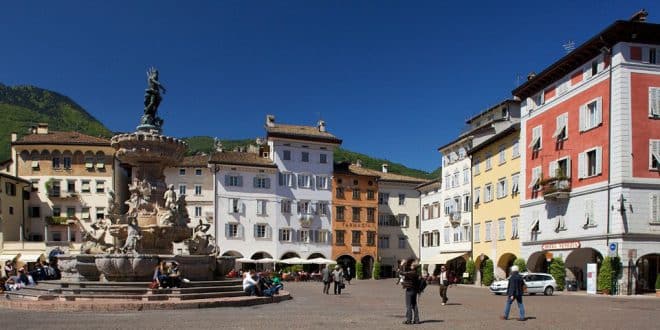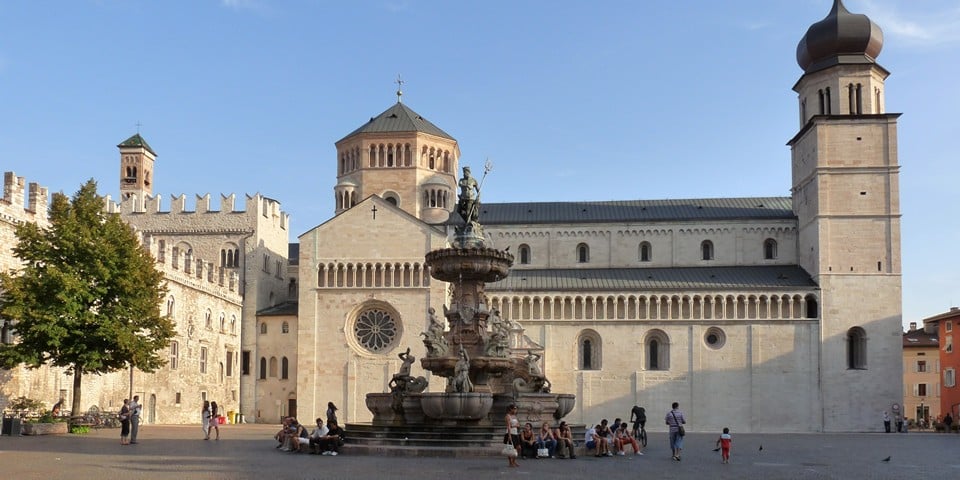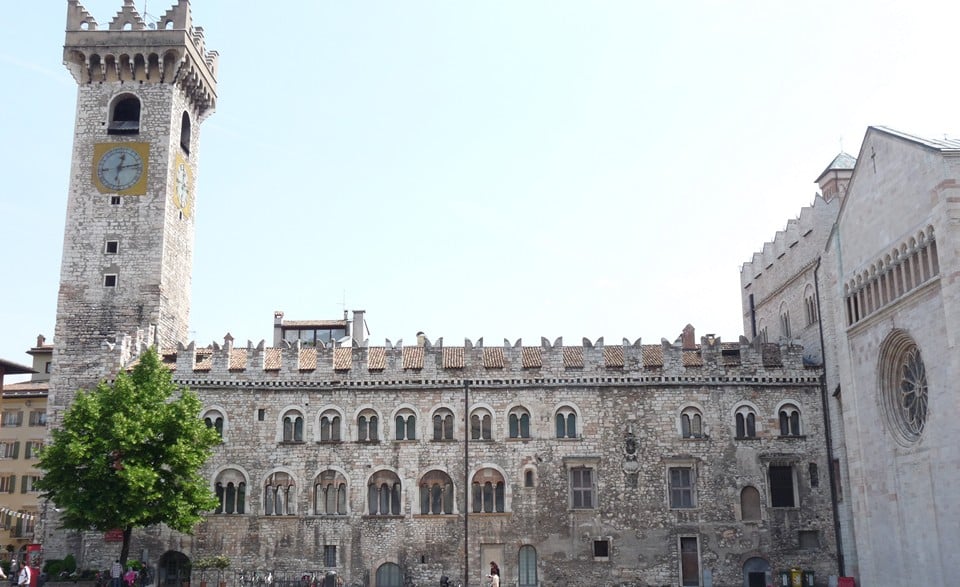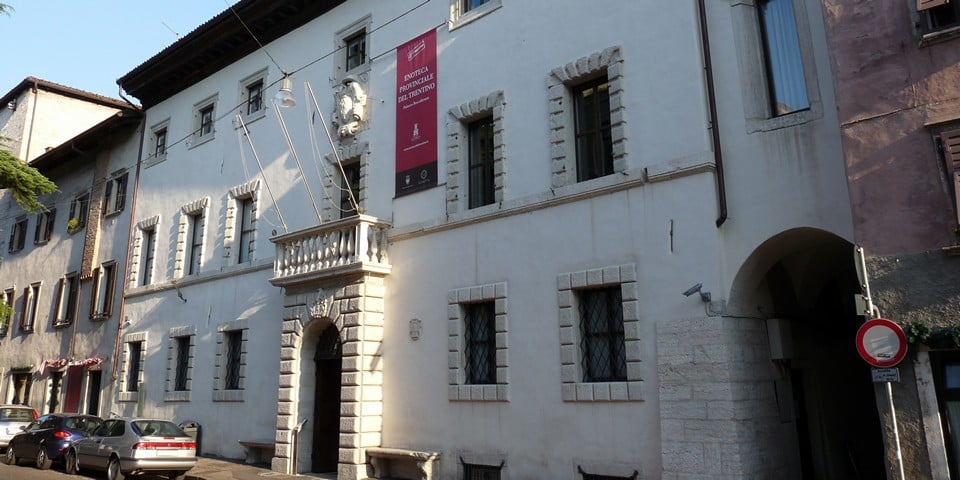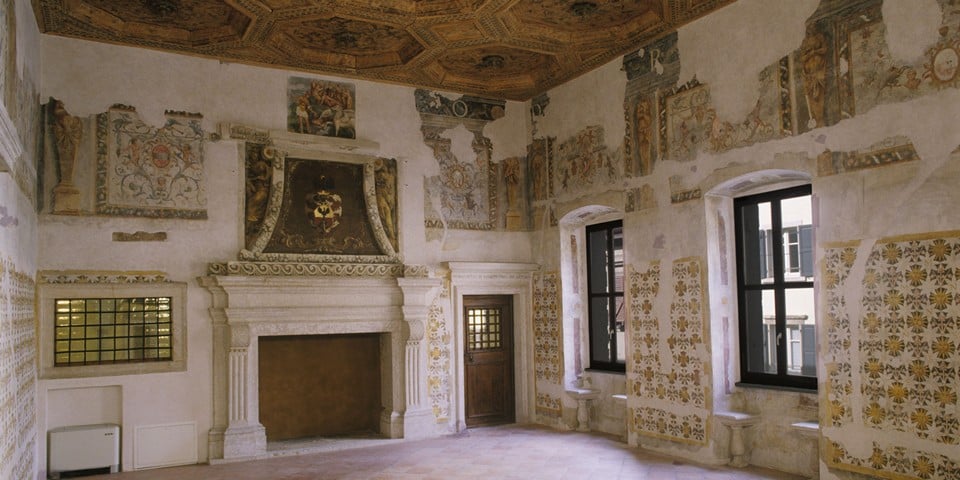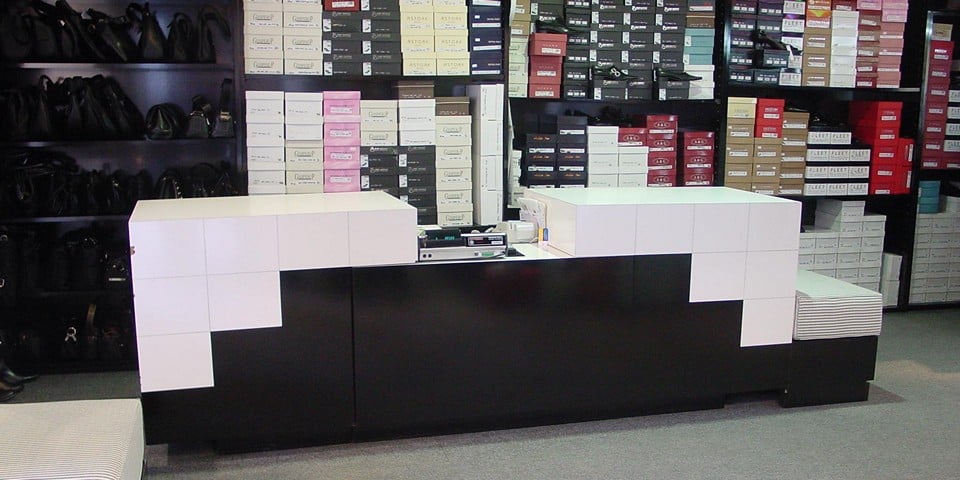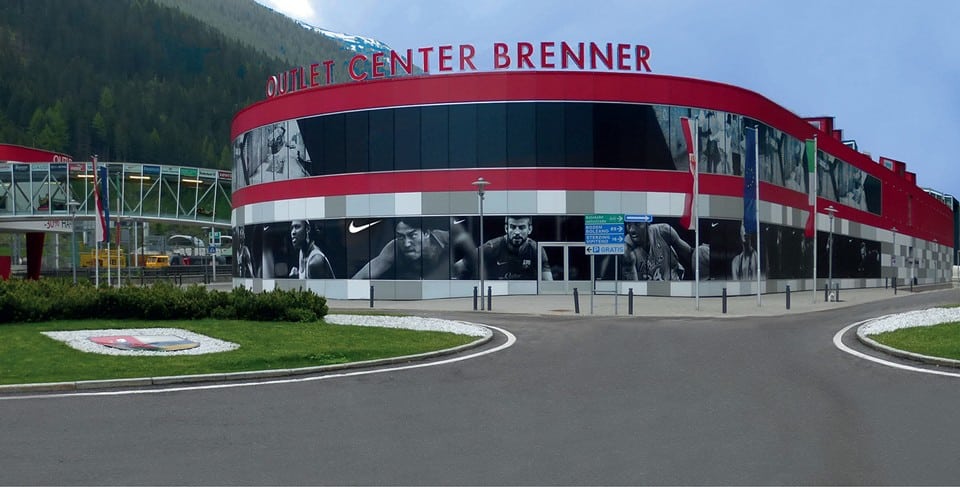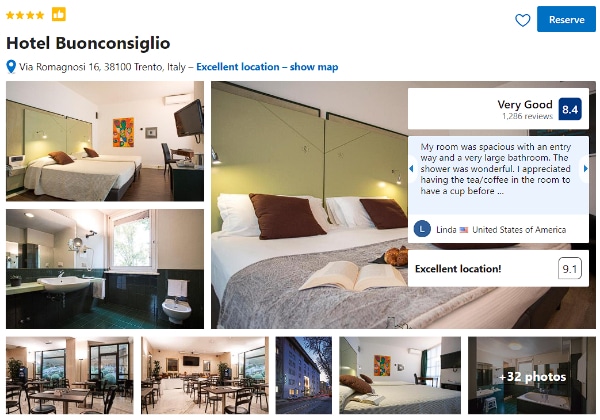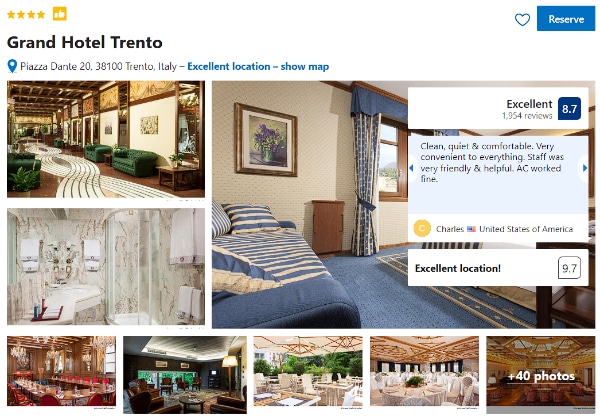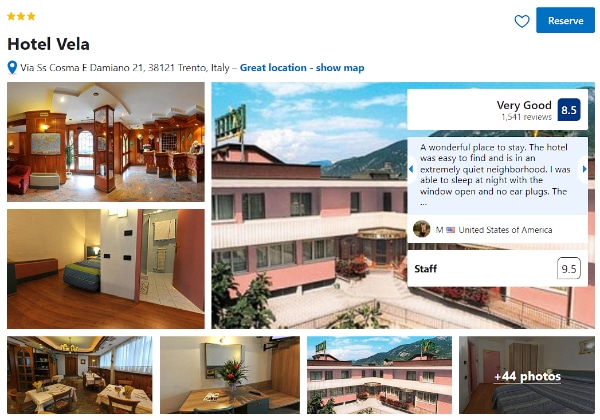Trento is called the gateway to the Dolomite Alps, a stunning mountain range that adorns Northern Italy. The city serves as the provincial center of the Trentino-Alto Adige region, where you’ll find the fusion of two cultures: the sober elegance of the Austrians blended with the warmth and emotionality of the Italians, giving this place a special charm that entices visitors to return again and again.
Page Contents
Frequently Asked Questions about Trento
What is Trento known for?
What to do in Trento?
What to see in Trento?
Interesting Facts about Trento
- Trento, a city in northern Italy, is the capital of the autonomous province of Trentino. Its history dates back to ancient times when it was known as Tridentum, a strategic Roman outpost.
- The Council of Trent, a significant event in the history of the Catholic Church, was held in Trento between 1545 and 1563. This ecumenical council addressed religious issues and led to significant reforms within the church.
- Trento is renowned for its picturesque location surrounded by the Dolomites, a UNESCO World Heritage site. The city’s scenic beauty offers a perfect backdrop for outdoor activities like hiking and skiing.
- The Buonconsiglio Castle, a prominent landmark in Trento, reflects various architectural styles and houses valuable frescoes dating back to the Middle Ages. It provides insight into the region’s historical and cultural heritage.
- Trento is a vibrant cultural hub with numerous museums, art galleries, and theaters. The MUSE Science Museum, designed by Renzo Piano, is a popular attraction that showcases the natural history of the Alps and provides an engaging experience for visitors.
History of Trento
The name of the city is related to the number three: Tridentum (in Latin, “divided into three”). Romans gave this name to the settlement of ancient Celts in the upper reaches of the Adige River when they arrived here during the time of Julius Caesar in the first century BCE. The valleys of three mountains: Vigolana (2,150 m), Monte Bondone (2,181 m), and Paganella (2,124 m) became a pivotal point for Ancient Rome’s advancement through the Alps into Europe. Legend also associates the name Trento with Neptune’s trident, the sea god who ascended from the Adriatic Sea through the Adige River to its source, claiming dominion over the Alps. Although historians have not found evidence of his reign in the surroundings of Trento, a magnificent fountain with a statue of the sea ruler adorns the city’s main square since the 18th century.
In the Middle Ages, Trento was a religious center, with the Bishop of Trento exercising both ecclesiastical and secular governance in his domains. In the 16th century, during the struggle against the Reformation, the renowned Council of Trent was held in the city (from December 13, 1545, to December 4, 1563), defending Catholic Church doctrines.
For over 300 years, the entire territory of the Trentino-Alto Adige region was known as South Tyrol and was under the rule of Austria-Hungary, which left its imprint on the landscape and the character of its inhabitants. The Italian population fiercely resisted the Austrians during World War I. After the war, the region finally became a part of Italy. However, even today, this area remains a “Tyrolean fairy tale,” also known as “German-speaking Italy.” There is no reason to rush or hurry here.
- Read also: Winter Holidays in Italy
Trento’s Attractions
Trento is often passed through in transit to ski resorts or summer destinations in the Dolomite Alps. However, it’s worth spending a few hours in the city itself, as its attractions can be an unexpected delight that enhances any journey. Which city landmarks should you definitely see during a one-day visit to Trento?
Buonconsiglio Castle
This edifice, located on a rocky hill, once dominated the area and served as the residence of the ruling bishop – the Buonconsiglio Castle (Castello del Buonconsiglio).
A powerful citadel with thick walls, arrow-slit windows, defensive towers, and a drawbridge – it’s a typical 13th-century Romanesque structure. Inside, there were dungeons and torture chambers. After 200 years, the towering Torre dell’Aquila (Eagle Tower) was added – a touch of the Gothic style. The tower’s interior frescoes, depicting scenes of the seasons, are precious examples of Gothic art.
In the 16th century, the Palazzo Magno (Great Palace) was added to the castle: pediments, galleries with colonnades, and frescoes on ancient themes – this marks the Renaissance period. The new extension to the castle, La Giunta Albertiana, with elements of Baroque, was built in the 17th century. The castle now houses the National Museum of the city.
Operating hours:
- March 12 to May 13: 9:30 am to 5:00 pm
- May 14 to November 3: 10:00 am to 6:00 pm
- November 5 to March 11 (Saturdays and Sundays): 9:30 am to 5:00 pm
Admission fee: 8€. Address: Via Bernardo Clesio 5.
Piazza del Duomo
The Cathedral Square (Piazza del Duomo) is among the most beautiful Italian squares.
Dominating the square is the temple dedicated to St. Vigilio (Cattedrale di San Vigilio). St. Vigilio was a martyr killed by pagans in the 4th century. The construction of the cathedral began in the 12th-13th centuries, creating a monumental Romanesque building with narrow windows cut into thick walls. Later, elements of Gothic architecture, such as the rose window, known as the “Wheel of Fortune,” and arcaded decorations were added.
The Baroque-style Chapel of the Crucifixion (Cappella del Crocefisso) was added in the 17th century. Exquisite frescoes, an ancient wooden crucifix, and the Madonna degli Annegati, venerated in the Catholic Church, adorn the interior of the cathedral.
- Opening hours: 10:00 AM – 12:00 PM / 2:30 PM – 5:30 PM. Admission: €5, €1 for children. Address: Piazza Duomo.
Palazzo Pretorio
Palazzo Pretorio is a building from the 13th century.
Its roof is adorned with characteristic Ghibelline battlements resembling a swallow’s tail, evidence that the bishops of Trento at that time supported the German emperors’ party in their struggle against the popes for secular power. The building now houses the Pretorian Museum, showcasing relics from the Trento Cathedral and skillfully crafted church furnishings, including carved altars and Flemish Renaissance tapestries.
- Opening hours: 9:30 AM – 12:30 PM / 2:30 PM – 6:00 PM; weekends 10:00 AM – 6:00 PM. Admission: €5.
City Tower
The City Tower (Torre Civica) rises next to the Pretorian Palace. This 11th-century structure was originally a prison. Public executions took place in the square under the tolling of the bell in the tower.
The building, adorned with clocks, stands at a height of 46.5 meters. Climbing 156 steps, visitors can enjoy a breathtaking panorama of the city and the surrounding countryside.
Open for visits from July 3rd to November 30th, every day except Tuesday. Guided tours are conducted at 4:00 PM / 5:00 PM. Admission: €7, combined with a visit to the Pretorian Palace – €10.
Fountain of Neptune
The Fountain of Neptune (Fontana del Nettuno) is a neoclassical monument dating back to the late 18th century. The aesthetics of this period express a rebellion against ecclesiastical asceticism, which distances people from nature. The ancient god Neptune, representing nature, rises before the cathedral dedicated to a Catholic martyr. The refreshing jets of the fountain symbolize Trento’s connection to the Adige River, which provides water to the city.
Two medieval houses adjacent to Piazza del Duomo (Casa Balduini and Casa Cazuffi) enhance its charm with beautifully painted façades. Casa Balduini (on the right) features 15th-century frescoes depicting virtues, love, and abundance, while the frescoes on Casa Cazuffi (on the left) are of later origin, dedicated to ancient mythology, and belong to the Renaissance period (16th century).
Church of Santa Maria Maggiore
The Church of Santa Maria Maggiore (Santa Maria Maggiore) played a significant role during the renowned Council of Trent in 1562-1563. It was built shortly before on the orders of Bishop B. Clesio, an extraordinary figure who prepared for this epochal council.
The style of the church is named after him, known as “Clesian”: a unique blend of Romanesque architecture with elements of the Renaissance. Its features include a strict portal adorned with a semi-circular arch, a portico, carved windows, and sculptures, as well as a faceted dome and an impressive bell tower.
- Address: Vicolo delle Orsoline, 1
Palaces
Medieval buildings and palaces adorn Trento, housing interesting museums.
Palazzo delle Albere
Palazzo delle Albere (Palace of the Poplars) is a defensive structure from the 16th century, once adorned with frescoes on the façade and poplar alleys. Inside, it boasted luxurious paintings.
Over time, the former decorations faded away, and it served as a barracks and hay storage. Now it houses the famous Museum of Modern Art – MART, with main branches in Rovereto.
- Museum hours: 10 am to 6 pm. Closed on Mondays.
- Address: Via R. da Sanseverino 45, Trento; Corso Bettini 43, Rovereto. Admission: $11.
Palazzo Roccabruna
Palazzo Roccabruna, a Renaissance-era building, stands out not only for its exterior appearance but also for its interior content. It houses a museum dedicated to the winemaking of the region, boasting 600 bottles of aged wine. Visitors can taste 100 varieties of wine while enjoying regional delicacies.
- Operating hours: Thursdays and Saturdays from 5:00 PM to 9:00 PM; during summer from 6:00 PM to 9:00 PM.
- Address: Via SS.Trinità 24.
Surroundings in Trento
Trento, the gateway to the Dolomite Alps, grants access to their beauty. For sports enthusiasts seeking adventure, there are canyoning, trekking, and rock climbing routes available at www.dolomitiavventura.it.
For those seeking a more relaxed getaway, Trento offers well-equipped places to visit.
Monte Bondone
Mount Monte Bondone (2181 m), also known as the “Summit of Trento,” is located 15 km from the historical center and is the oldest ski resort in the area, with the first lift in Europe established here in 1934.
Today, it is an excellent family resort, offering hiking and biking trails and visits to the botanical garden during the summer. Regular buses from Trento to Monte Bondone are available.
Valle dei Laghi (Valley of Lakes)
Valle dei Laghi stretches from the foothills of the Dolomites to Lake Garda.
Over a 35 km area, there are seven beautiful lakes of various sizes. Fishing enthusiasts can catch trout, pike, or carp here, provided they have the necessary permits. Detailed information about the region can be found at www.trentinofishing.it.
Tourist Cards
Tourist cards in the region offer visitors the opportunity to save on local travel and museum visits, especially for those without a car.
- Guest Card Trentino allows free use of public transport within the Trentino province, access to museums, architectural landmarks, and national parks. Families can opt for the “Family” card. Please note that Guest Card is not valid in Alto Adige. The cost of the card is 40€. Details can be found at www.discovertrento.it; www.visittrentino.it.
- Parco Card is valid for 14 days in Trentino and includes parking, regional bus travel, visits to nature reserves, museums, and amusement parks. The card costs 20€ for one person or 40€ for a family. For more information, visit www.pnab.it.
- Trento Rovereto Card is valid only within the cities of Trento and Rovereto. It includes public transport, museum visits, bicycle rentals, wine tasting, and discounts on local concerts and festivals, all free of charge with the “Trento-Rovereto” card. The card costs 20€. For details, visit www.visittrentino.it.
- Museomobil Card is valid in the Alto Adige province and grants access to all cable cars, buses, and trains in the region. It allows visits to up to 78 museums. The card costs 28€ for three days or 32€ for seven days. Museomobil Card provides excellent travel opportunities in the Dolomite Alps and can be purchased in Bolzano. More details can be found at www.mobilcard.info. Please note that transporting bicycles on trains and buses in the region is not allowed, so bike rental addresses may be needed: www.suedtirol-rad.com.
Holidays of Trento
Trento is rightfully considered a city of festivals, which take place here every month:
- The Christmas Fair in Trento is one of the best in Italy.
- Trento Film Festival is a spring film festival dedicated to mountaineering.
- The main city celebration is the Feast of Saint Vigilius (Fuochi di San Vigilio), held in the second half of June; the folk festivities last for two weeks.
- Polenta Festival – traditional cornmeal dishes celebrated in the autumn.
In 2017, Trento offers about 40 festivals, details of which can be found here: www.discovertrento.it.
Shopping in Trento
The sales season takes place in the region twice:
- Winter: from the beginning of January to February 15th.
- Summer: from July 15th to the end of August.
In Trentino – Alto Adige, the standard of living is very high, and prices for new collections, as well as food products, are consistently high. Therefore, it’s useful to know where in the city you can buy groceries at a lower price.
Grocery Stores
“Conad” supermarket often offers products at reduced prices, occasionally holding sales, which are advertised at the entrance. It has a good selection of sausages, cheeses, and wines. Address: Via Torre Verde 26; within walking distance from the bus station.
“Poli” supermarket with optimal prices for groceries is conveniently located in the city center where there is not an abundance of grocery stores. Address: Via delle Orfane 2.
Shoes, Leather, Souvenirs
“Romarco” – a renowned Italian leather goods and footwear store, with prices above average. Address: Via San Vigilio 1.
“Escordio” – a store offering products from different price categories and brands. You can find “Janet & Janet” shoes next to “Calvin Klein” slippers and “Roberto Guerrini” boots. Address: Via San Pietro 51.
“Galleria Tirrena” – a street with clothing, footwear, and cosmetics stores at moderate prices.
“Valentini” – a little shop with high-quality souvenir knives at low prices (Swiss folding knives – 10-20€). Address: Via San Marco 36.
Outlet in Brennero
The most well-known outlet in the region is located in the municipality of Brennero – Outlet Center Brennero. It offers products from brands like Puma, Timberland, Benetton, and others, as well as items from small Italian companies. Address: Via S. Valentino, 9/A, 39041 BZ Brennero.
Where is the best place to stay in Trento?
When traveling to the Dolomites with a stopover in Trento, it is wise to choose a hotel closer to the city center.
Hotel Buonconsiglio – convenient location near the station
Hotel Buonconsiglio is conveniently located near the train station and bus stops. Major attractions are within walking distance. Breakfast is served every morning. Guests enjoy the benefit of free local transportation and access to the Trento-Sardagna funicular. The hotel provides the Guest Card Trentino free of charge.
Grand Hotel Trento – the best according to reviews
This luxurious hotel Trento is situated in the central part of the city, close to the monument of Dante Alighieri. The rooms are furnished with comfortable furniture, the restaurant offers a menu based on local cuisine, and the bar serves exquisite wines. Breakfast is provided every morning. The hotel’s special feature is offering the Guest Card Trentino.
Hotel Vela – with mountain views
Hotel Vela is located 2 km from the city center and offers a stunning view of the mountains. It provides free parking and rooms with bathrooms and air conditioning. Guests can enjoy a buffet breakfast, and the restaurant serves local cuisine and pizza.
Getting There
Trento is located at the following distances from the nearest airports:
- Bolzano Airport (Bolzano) – 60 km;
- Verona Airport (Aeroporto di Verona-Villafranca) – 90 km;
- Venice Airport (Aeroporto di Venezia Marco Polo) – 195 km;
- Malpensa Airport in Milan (Aeroporto di Milano-Malpensa) – 245 km.
For convenient travel in the region, especially during the summer, it is recommended to rent a car, which can be done here: auto.italy4.me.
From Milan to Trento, you can take a train with a transfer in Verona (Verona Porta Nuova). The journey takes about 3 hours, and the ticket costs 30-50 €. By car, the travel time is approximately 2.5 hours, and the toll fee is 15€ out of the total cost of 35 €.
From Verona, a train ticket costs 7-8 €, and the journey takes 1 hour. By car, it takes 2.5 hours with a cost of 15€ for the road.
Traveling through the Trentino-Alto Adige region, exploring Trento, and the beauty of the Dolomites will be a memorable experience that will stay with you for a long time.
 Italy for me From Italy with love
Italy for me From Italy with love

